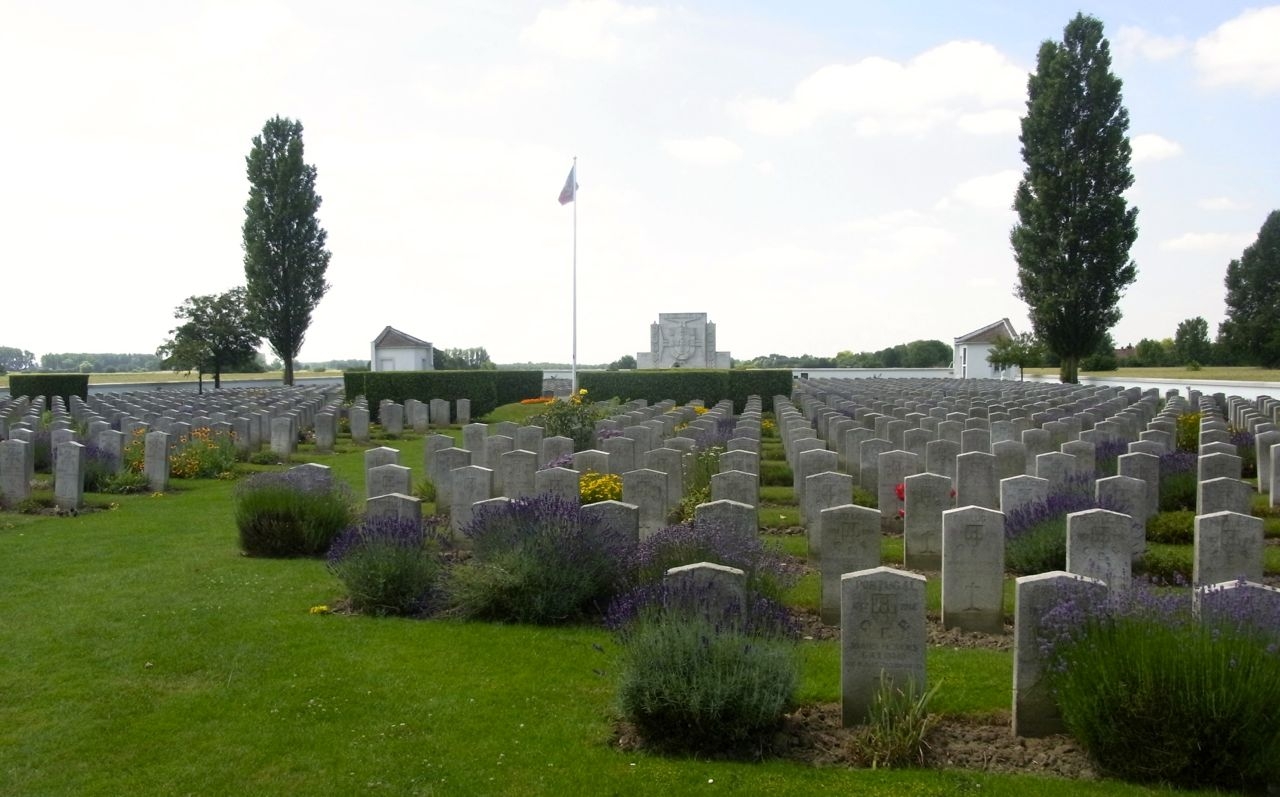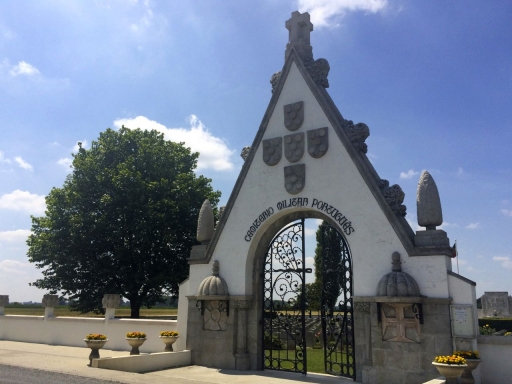This article has been written for Centenary News by Bernard Hornung, the Chairman of the Anglo-Portuguese Society – about Portugal’s role in the First World War, and plans for a memorial in the UK. Germany declared war on Portugal in March 1916.
Memorials for a King and a Country
Close to the Neuve-Chapelle Indian Memorial stands a white walled cemetery with an imposing entrance. On one side stands the Chapel dedicated to Our Lady of Fatima; on the other, the Portuguese National Cemetery of Richebourg, which is the final resting place of 1,831 Portuguese soldiers and the principal place of remembrance to honour the Portuguese fallen of the Great War, in Northern France.
Other than the individual graves, and a fireplace near Lyndhurst in the New Forest, built by Portuguese troops, I do not believe that there is a war memorial dedicated to the Portuguese dead of the First World War, in this country. Portugal remains our oldest ally. The last King of Portugal also merits recognition for his unique and selfless contribution to the Allied cause.
As we approach the Centenary Anniversary of Germany’s declaration of war on Portugal, 9 March 1916, we reflect upon the Anglo-Portuguese Alliance, which goes back to the Treaty of London. This was sealed in St Paul’s Cathedral on 16 June 1373, and subsequently ratified by the Treaty of Windsor, sealed in the Chapter House of St George’s Chapel, Windsor Castle on 9 May 1386. Portugal’s participation in the Great War is worthy of remembering, and we should consider supporting the creation of a memorial dedicated to Manuel II and to the Portuguese fallen.
Portugal became a Republic in 1910 after a revolution led by the country’s military toppled King Manuel II, (his father, King Carlos I and elder brother had been assassinated two years earlier.) A liberal constitution was enacted in 1911, and Manuel Jose de Arriaga was elected as the republic’s first president.
Portugal entering the War
By entering the war at the side of the British, Portugal hoped to protect its African colonies, Angola and Mozambique, which previously had been the subject of secret agreements between the British and the Germans in 1898.
Skirmishes broke out in both Angola and in Mozambique in 1914, between German and Portuguese colonial troops in Africa, and the Germans instigated tribal revolts. There was no formal declaration of war, and initially the British were content to accept material aid from Portugal, but were less enthusiastic about the young Portuguese Republic actually taking part in the fighting. The growing logistical problems affecting the Allies and German U-boat action did however lead the British to ask the Portuguese Government in December 1915 for permission to requisition all the German ships moored in their ports. This was complied with in February 1916, in reaction Germany declared war on Portugal on 9 March 1916.
The Portuguese Expeditionary Force was established on 22 July 1916, and sent to France in early 1917, under the command of General Tamagnini, where it landed in the Breton port of Brest and was subsequently stationed in Aire-sur-la-lys, a small town in the region of Pas-de-Calais. The Portuguese troops were from then on attached to the 11th Corps of the 1st British Army under General Horne. In October 1917, the Portuguese Expeditionary Force comprised nearly 57,000 men.
French Flanders
In November 1917 General Horne entrusted the Portuguese with the defence of an eleven kilometre front in French Flanders which stretched from Laventie to Festubert. The Portuguese set up their headquarters at Saint Venant. The area they had to defend, a plain between the river Lys and the La Bassée Canal, was very damp and muddy, which soon had a negative effect on morale. The Portuguese soldiers equipped in lightweight uniforms, found it enormously difficult to adapt to the particularly inclement conditions of the winter of 1917/1918. In December 1917 the Portuguese Government fell in a coup d’etat which brought Sidonio Pais to power. Less enthusiastic than its predecessor in its support for the Allies, the new government instituted a new and far less strict system of leave which allowed soldiers to return home for extended periods.
This resulted in the Portuguese Expeditionary Force having fewer officers to lead its men. To make matters worse, Great Britain was devoting all its shipping to the transport of soldiers from the United States, which had entered the war, and therefore had no available capacity to bring in Portuguese soldiers to reinforce their comrades stationed in Flanders. As a consequence, insubordination grew steadily in the ranks.

More than 1,800 soldiers are buried at the Portuguese Military Cemetery, Richebourg (Photo: Centenary News)
Battle of the Lys
When the Battle of the Lys broke out on 9 April 1918, two depleted divisions of the Portuguese, wanting in men and officers, had to take on nearly ten German divisions, spread over three successive lines. Except for a few pockets of resistance the Portuguese were completely swept aside by the German offensive, “Operation Georgette.” The next day, shoulder to shoulder with the Scottish, the Portuguese survivors defended La Couture before eventually being forced to withdraw. On 13 April the Portuguese units were sent to Lillers and Steenbecque to reinforce the British 14th and 16th Divisions posted there. The Germans took Estaires, Armentières, and Bailleul but failed to take Béthune and Hazebrouck. “Operation Georgette,” was called off on 29 April.
Thereafter the Portuguese Expeditionary Force was grouped into a single division and took part in the Allied Offensive of 1918. By the time the ceasefire was announced on 11 November 1918, the Portuguese had reached the river Escaut and had entered Belgium.
Of the 56,500 Portuguese soldiers sent to the Western Front, approximately 2,100 were killed, 5,200 wounded and 7,000 taken prisoner. In honour of the soldiers who defended the village of La Couture the French and Portuguese governments inaugurated a monument there in 1928.
King Manuel II
A memorial to the Portuguese fallen of the Great War in the United Kingdom is long overdue. The compelling case of such a memorial to include one dedicated to the last King of Portugal, is strengthened by the exemplary contribution made by Manuel II, when in exile, living at Fulwell Park, Twickenham.
Although he was linked by marriage to the Hohenzollern family, and as such to Kaiser Wilhelm, Manuel II immediately gave his support to the Allies during World War I. He justified himself thus: “It is the policy of our traditional and secular alliance, always followed by my late father. Now all there is left is for us to observe the unfolding of events, fervently hoping for a victory of our allies.” This decision exposed another gap between the exiled King and his followers inside Portugal. Many of them blamed Britain for the fall of the monarchy and sympathised with Germany, but Manuel II insisted that the Anglo-Portuguese Alliance was the best way of assuring Portuguese independence. When Portugal formally entered the war on the side of the Allies in 1916, he shocked his followers by ordering them to support the Republican government, explaining that the survival of the nation must take precedence over the restoration of the monarchy.
The King placed himself at the service of the British Red Cross and wearing the uniform of a British Army officer, he started touring hospitals throughout the country. Thanks to his efforts, an orthopaedic military hospital was opened in Shepherd’s Bush in 1916, where Manuel II spent many long hours. His name is also associated with the Hammersmith Military Hospital and, above all, linked to the adoption of a new orthopaedic treatment method, which had been followed on the Continent. More tours were made of hospitals in Scotland and in Ireland. All of this work brought the King a certain degree of prominence, to the point of arousing suspicions inside the Portuguese Republic.
At a certain point in 1918, following a nervous breakdown due to exhaustion he went to recuperate in a seaside resort and wrote to King George V: “I feel I should write a few lines to tell you that our thoughts are with you in this terrible moment. I want you to know that our prayers have been, more than ever, with your wonderful troops. May God bless them and bring them a swift victory. I wish I could be of use to you. You know, dear Georgie, that my modest services are always entirely at your disposal and I assure you that it would bring me much joy knowing they could be of use. I did all I could for the special orthopaedic hospitals and I have the consolation of knowing that I fulfilled my duty. But I wish I could do more in yet another anxious moment for you, who I care for so much, and for this country I so much admire and consider to be my second country.”
In contrast with her husband’s activity, his wife Augusta Victoria kept to her private sphere and was often observed in tears during the Mass at St James’ Parish Church in Pope’s Grove, Twickenham, where the royal couple worshipped.
King Manuel II died suddenly aged 42, on 2 July 1932. The epitaph on his tomb reads: “Here rests with God, King D. Manuel II, who died in exile having served his country well.”
Anglo-Portuguese Memorial
Between 1914 and 1918 more than 100,000 Portuguese soldiers went to war. They fought in Africa and in Flanders, with nearly 40,000 casualties. Almost 12,000 men died, including Africans from both Angola and Mozambique, serving in its Armed Forces. Many others were wounded, 6,000 more reported missing and more than 7,000 were taken prisoner. Civilian deaths exceeded the pre-war level by 220,000; 82,000 caused by food shortages and 138,000 by the Spanish ‘flu.
The Anglo-Portuguese Society is supporting the parish priest at St James, Fr Ulick Loring to commission two memorial windows. One will be dedicated to the last King of Portugal and the other to the Portuguese fallen of the Great War. A fund raising programme has commenced and the objective is to raise £18,000 this year, so that the windows can be dedicated on 9 April 2018, the Centenary Anniversary of the Battle of the Lys.
At 5:15 pm on Monday 9 May 2016, there will be a Special Evensong at St George’s Chapel, Windsor Castle, after which there will be a retiring collection for this worthy cause. All are most welcome, and no tickets to gain entrance are required.
A Solemn Requiem Mass will be said at the Guards Chapel at 12 noon on Friday 22 July 2016, to mark the Centenary Anniversary of the formation of the Portuguese Expeditionary Force, and to honour the Portuguese, Angolans and Mozambicans, who sacrificed their lives in this conflict. This will be a ticketed event. Applications are to be made to the Anglo-Portuguese Society: angloportuguese@talktalk.net
Article: ©Centenary News & Author
Images: Centenary News
